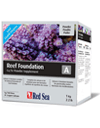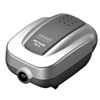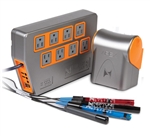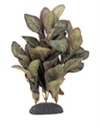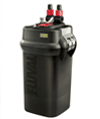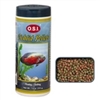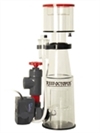Top 10 Aquascaping Tips
 1) The Rule of Thirds
1) The Rule of Thirds
The “Rule of Thirds” is a visual arts composition technique. The idea is to avoid making the focus of the aquarium the center of the aquarium. When the focus is the center the eyes tend to not view the entire aquarium. By making the emphasis points of your aquarium away from the center, the viewer will notice the entire aquarium.
The “thirds” refers to sectioning the visual display—the aquarium in this case—into thirds. Placing key corals, decoration and plants in these intersections will make your aquarium more pleasing to the eye. Some take this very literally and apply masking tape to the front glass in the pattern of a Tic Tac Toe board. The intersections of the tape lines provide points where you will want to place key decorations.
2) Background
An aquarium background is an absolute must have for an attractive aquascape. Black backgrounds allow you to stay focused on the contents of the tank while visually eliminating equipment and cords behind the aquarium.
You may also like frosted or white back grounds, but keep in mind that these colors only look good if you religiously clean the back glass. Black is the most forgiving when it comes to cleaning.
3) Space
There can be a tendency to completely fill an aquarium with rocks, plants, and coral. It often looks much better to leave open space in an aquarium. This provides both visual contrast and a place for fish to swim.
A good rule is to aim to have at least as much open space as hardscape (
rock and wood). Plants and corals will grow to fill more space over time, so give yourself a good buffer.
4) Scale
When you put a big fish (
or small fish that will become big fish) into a small tank it makes the tank feel small. With this in mind, smaller fish make aquariums feel larger as do fine gravel, plants with small leaves, thin branched wood, small polyp coral, and thin branched corals.
Many people want to make their tank feel massive and selecting small fish and smaller aquascaping structures can have this effect.
Other times you may want to make a desk tank feel exceptionally small. Choosing larger gravel, rocks and large leafed plants will achieve that effect.
5) Color
Contrast can help to exaggerate the colors of your fish, coral and plants. In reef aquariums, avoid placing all of your green corals together, blue corals together or orange corals together, and instead try to intersperse the colors.
In planted aquariums try to look for plants that are differing shades of green or even red and purple. It can help to look at a color wheel to remind yourself of complementary and supplementary colors. Also consider fish like cardinals, or neon tetras. The red and blue colors are an excellent contrast against the predominately green background of most planted aquariums.
6) Shape
Just as contrast in color can be good, contrast in shape can make your aquarium much more interesting. In reef tanks try to incorporate encrusting, branching, and plating corals. Any tank dominated by only one type can be visually boring.
In planted aquariums, try to mix round broad leafed plants with thin leafed plants. Mix tall plants with shorter plants.
7) Lighting
Omni-directional lighting from florescent lights can give an aquarium a flat or still appearance. Point source lights such as those from
Kessil can add depth and glitter lines that bounce off moving water—making the tank feel alive. If replacing your light fixture is not an option, just adding extra water movement at the surface can increase the amount of glitter lines. You can also get creative by highlighting structures and even specific corals or plants with spotlight style effects.
Lights with adjustable colors, such as the
Kessil LEDs,
Fluval Marine & Reef LEDs,
Fluval Fresh & Plant LEDs and
Ecotech Marine Radion will allow you to adjust the light spectrum to suit your desired aesthetics. Bluer lights help to bring out green, yellow and florescent colors while warm yellow light can increase blue and purple colors.
8) Movement
When an aquarium is too still it can look dead. Adding water movement along with plants or corals that sway with the current can help to add more visual interest.
Fish also provide movement, but not all fish do so equally. In fresh water your plecostomus may only move a little every couple of minutes, so it may be good to also include an active fish, such as a rainbow fish.
In saltwater, anthias, tangs and chromis move a lot while fish like groupers, eels and jawfish can sit still for long periods.
9) Equipment
Many great aquascapers believe anything that distracts from the aquascape should be removed. With this in mind, work to eliminate all equipment from view, or make it as attractive as possible.
In freshwater, power filters and heaters in the tank can be unattractive. Using canister filters, inline heaters and CO2 reactors will reduce clutter in the tank. Better yet, look for integrated equipment. The
OASE BioMaster Thermo Canister Filters include an integrated heater. To the Fluval Filters and the OASE Filters you can add an inline UV sterilizer (
see Fluval UVC In-Line Clarifier w/ Hose and OASE ClearTronic UVC 7W UV Clarifier).
In salt water, you can use a sump to hide away your protein skimmer, filtration media, thermometer, heater, pumps and more. Consider closed loops or creative solutions like the
Tunze Stream Rocks to hide your pumps.
10) Maintenance
Your aquascape doesn’t just need to look good, it needs to keep looking good. Make sure that you allow yourself plenty of room to clean. Avoid placing large amounts of rocks flat on the bottom of the tank. This can lead to excessive detritus build up.
Makes sure that there is enough room between the glass and the hardscape to fit your hands in to clean.
Keep in mind it is nearly impossible to gravel vac super fine substrates.
Pale or white rocks and decorations will need to be meticulously cleaned to keep them looking attractive.







